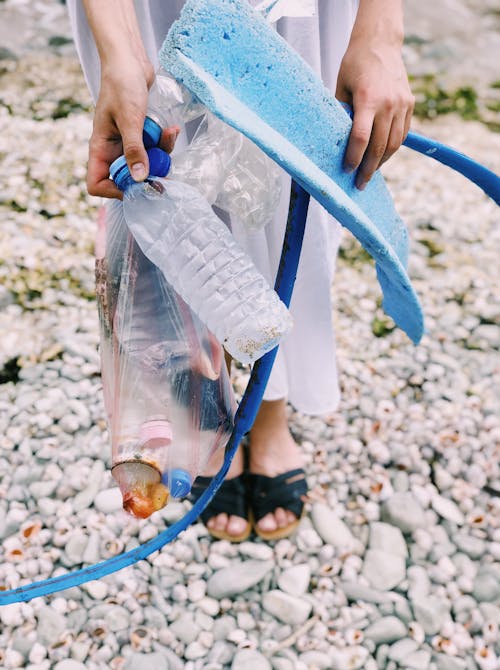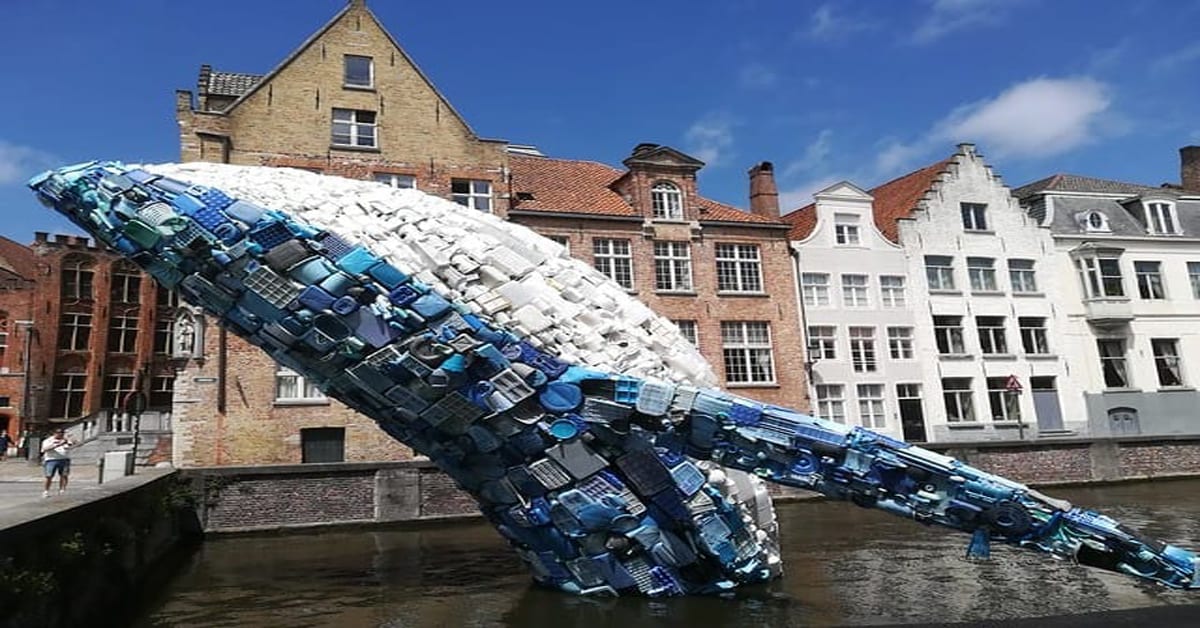Cool, calmness and peace—these are words that best describe the vibe of a blue and green ocean. It is serene looking, a salve to the eyes. It is also associated to healing. The minerals found on its waters—such as the mineral salts—are stronger and richer than in any other water forms. But what if, the oceans that give us tranquility and healing, needs it the most? In fact, we do not need ‘what ifs’ to imagine this. We have the whole world telling us this sad truth: Our oceans are polluted.

Just several days ago, ocean pollution has caught the eye of the media. This is due to a study conducted by The Pew Charitable Trusts and SYSTEMIQ, saying that the amount of plastic pollution in 2040 will triple. This means “more than 1.3 billion tons of plastic waste will flow into the world’s oceans and land over the next two decades without widespread intervention,” says the report. The major contributor? Single-use plastics coming from municipal wastes and households.
Sadly, this only one part of ocean pollution. Aside from the garbage that goes into the bodies of water, oceans are also harmed from sunscreen and topical we use, oil spills, sewage, agricultural and aquaculture runoffs, industrial wastes, eutrophication, carbon dioxide and noise. The result? Marine ecosystem is drowning in all types of trash imaginable.
In this article, learn what you can do to save our ill oceans.
Where are polluted oceans?
Oceans cover more than 70% of our planet. This makes it our most valuable natural resource. Its vastness makes it a home to the majority of Earth’s living species, a great portion of it are marine plants responsible to 70 to 80% of the overall oxygen in the planet. But instead of seeing them as treasures, the majority of people assumed that oceans can endure wastes. The trash and chemicals that go into the biggest body of water is deemed invisible, not knowing they have collective destruction. Today, we are more than informed of the limits of the ocean.
Plastics are trashing our oceans. It can be as small as microplastics or as big as an SUV van. They cover the coastline. They are on the water’s surface, such as the famous Great Pacific Garbage Patch or simply the “trash island”. Or reach as deep as the unfathomable Mariana Trench.
Here’s the tragedy of Earth’s oceans and their battle against pollution.
Pacific Ocean
The largest body of water is tragically the most polluted. The Pacific Ocean contains both sumptious paradise-like waters and pollution, particularly the Great Pacific Garbage Patch, which the European Commission dubbed the “World’s Largest Landfill”. Over 3 million tons of trash floats here, from whirling currents in the Pacific Ocean that pull trash and pollution into the ocean. Most alarming of all, this path is the size of Europe.
According to The Ocean Cleanup in 2018, the layer patch is around 180 times higher than that of marine life, where 84 % of plastic samples contained at least one chemical pollutant. This signifies polluted plastics could be the main food source for the organisms inhabiting the region, For example, a sea turtle had a 62.5% of plastic while only 37.5% of food was found on its stomach.
There is another garbage dump inside the Pacific Ocean: the North Pacific Gyre off the coast of California, twice the size of Texas. There, the number of floating plastic pieces outnumbers total marine life six to one.
In the South Pacific, where there are less people, there are 491 billion pieces of plastic floating.
Indian Ocean
The Indian Ocean also has its own garbage patch – containing over a million pieces of plastic. According to Marcus Eriksenin in an interview with National Geographic, a marine scientist and founder of the 5 Gyres Institute who discovered the patch in 2010, the patch comprised a massive area of about five million square kilometres in size, however with no clear boundaries since it changes with the season and very fluid. Contributing to this pollution are the Indus and Ganges Rivers that both drain into the Indian Ocean.
Atlantic Ocean
The Atlantic holds over a trillion pieces of plastic. Most of these float across the North Atlantic garbage patch within the North Atlantic Gyre. The North Atlantic Ocean stretches between Western Europe, West Africa, the east coast of the United States, and Northeast South America.
In the report of Doyle Rice of USA Today dated April 16, 2019, since 1957, the scientific gear utilized to measure plankton in the North Atlantic Ocean has been clogged by plastic trash of about 669 times. Majority of those entanglements have occurred since the late 1990s, depicting how ocean plastic has increased rapidly in the past two decades. Scientists say that the said entanglement on the gear amplified by around ten times since 2000.
Causes of Ocean Pollution
Plastics

Plastics are the main pollutant in the oceans. Taking practically forever to degrade, plastics break down and damage the ocean from surface to bottom. The most common plastic trashes found floating in the oceans or strewn along shorelines are food packaging, sachets, cigarette butts, bottle caps, tableware, plastic bottles, plastic bags, nappies, clothes, razors, plastic toothbrushes and plastic straws.
Common culprits of plastic waste in the ocean are beachgoers, beach dwellers, leftovers from storm drainage systems and shipping by-wastes.
Oil Spills
Oil is the fastest and worst pollutant in the ocean. Oil spills result from oil dumping in the ocean, and drainage from land. Oceans literally die from oil spills. They suffocate marine life to death, and change the entire ecosystem of affected areas, such as a long coastline or deep ocean.
In some cases such as an Adult fish that has been exposed to oil is observed to experience reduced growth, changes in heart and respiration rates, enlargement of liver, fin erosion and even reproduction impairment. Oil could also make Fish and shellfish unsafe for humans to consume as they brought danger to health.
Chemical Waste Dumps
For a long time until the 1970’s, companies and institutions deliberately dump chemicals and other garbage such as pesticides and radioactive waste from nuclear reactors, industrial waste (such as heavy metals and acids), and drained sewage into the oceans. All this is under the fatal assumption that everything thrown underwater will dissolve to safe levels.
Ships
Ships are a major cause of ocean pollution. They contribute to 20 percent of the pollution by dumping waste, cargo, oils, and other chemicals. Among the worst ships in terms of pollution are cruise ships.
Cruise ships contribute to the 24 percent to the total solid waste generated by maritime traffic. Luxury vessels such as cruise ships can create seven tons of waste in one day. The solid wastes emitted from the cruise ships include paper, aluminium, plastics and cardboards producing unwanted debris on the ocean.
Cruise ships are also one of the culprits in coral destruction. One example was in 2017 when a British cruise ship MS Caledonian had crashed onto the Indonesia’s coral reefs. It destroyed 17, 222 square feet of coral reefs which caused $19 million permanent damage.
Noise
Human activities can produce a lot of noise within the oceans like seismic surveys, oil exploration, military sonar, and mass cargo shipping. These noises affect many forms of marine life that depending on their sense of hearing for survival, communication and navigation.
Noise in ocean may result to internal injuries and stranding to marine animals, for example the confusion from the Navy’s sonar has been linked to whale stranding. Other than that, marine animals may suffer physical damage such as hearing loss which affects their ability to communicate, to sense danger, to hunt for prey and to find a partner. Due to this, they leave valuable habitat and can have a negative impact to the marine.
Effects of Polluted Oceans
Polluted oceans are detrimental. They can lead to various outcomes that affect the environment as well as humans, from creating an imbalance or losing marine bio-diversities to loss of livelihood of some communities. They also affect food chain through contamination and consumption which can post public health issues caused by micro-plastic.
Mass animal deaths
There is undeniable fact that ocean pollution is the primary cause of loss in biodiversity as well as subsequent mass extinctions on Earth as marine flora and fauna are all affected. Imbalance ecosystem caused by toxic plastics and chemicals in the water which bring out contamination has led to the death of animal and plant species. Migration to avoid contamination has been observed on some animal species. However, this possesses a risk on other ecosystems which may suffer from invasive species.
Ingesting of plastic wastes is considered fatal for marine animals. And this is inevitable as they take in micro-plastics mistakenly for food. In the Pacific Ocean alone, Fish consumed an estimated 12,000 to 24,000 tons of plastic per year. According to scientists, the micro-plastics from the gut of the fish travel to its blood streams in which physical damage in fish occurs, such as inflammation of organs. Studies also found signs of ingested micro-plastics leaching of hazardous chemicals.
Moreover, discarded plastics like fishnets have caused the entanglement of many sea animals. Entanglement is one of the reasons of over 100.000 death of sea mammal per year. Entanglement hinders the sea animals to move, breathe and look for food and mate.
Aside from plastics, hazardous chemicals contaminate the ocean affecting the living conditions of marine animals. Chemicals such as fertilizer runoff create eutrophication that contributes to algal bloom which depletes the water’s oxygen content greatly affecting marine life. Some areas show significant decrease of fish population. Due to fishes’ sensitivity to their living condition and areas become excessively contaminated, massive fish kills happen and worse, extinction of some species, which is a clear manifestation of lower fish population.
Harm to Coral Reefs
Coral reefs are not exempted. Since corals are living organisms, they are also affected in a drastic manner. Many corals are quite sensitive to changes in water temperature and water quality. As pollutants and sediment enter the water, they can speed the growth of algae and lower water quality. Making corals prone to diseases and eventually die. When coral reefs die, this could create a loss of habitat to some marine species.
Loss of Livelihood for Locals
Fishing and tourism are two most significant source of income for some people around the globe. The drop in fish populations in conjunction with a decrease in tourism may lead to the loss of livelihood of locals situating in the contaminated areas. Losing both of these sources of income will also mean losing food on the table and other basic things needed by their families. This may force them to leave, give up their homes or become victims of exploitation and abuse.
Another is the health problem that will result to economical problem, for instance, a fisherman exposed to oil spill may got illness like respiratory damage and decreased immunity to other diseases. The fishermen’s deteriorating health will hinder him to continue his job while his financial burden will continue surging due to medical and household expenses.
Food Chain Contamination
As 70% of the earth is composed of water, people think all pollutants would disappear or get diluted which is unlikely to happen. In reality, these pollutants may come back with a dangerous package as these pollutants will enter the food chain.
In the Pacific Ocean, fish and marine life comprise the food chain are helping to maintain life’s natural balance and keep marine species from becoming extinct. However, the high amount of plastic in the Pacific Ocean has disrupted the food chain and fish species are actually in danger. The University of California San Diego Scripps Institution of Oceanography had conducted a research where the Institute researchers collected 141 fishes of 27 species had found that 9.2% of the fish had small bits of plastic debris in their stomachs. And these marine animals consuming plastic are actually present in our food chain making the wastes more dangerous and more poisonous as they come back in the form of food.
Public Health Issues
Annually, there are 250 million cases of human diseases are being recorded. And contaminated coastal water is responsible for it. 1 out of 20 is at risk from becoming ill after a single bathing visit in waters considered ‘acceptable’ by microbial standards. Aside from microbial presence, there is a projected rate of about 150 % increase of water acidity by the end of the century. In Mediterranean Sea, 80% of discharged sewage is untreated leaving more contamination on water and eventually to marine life.
Furthermore, about 50, 000- 100, 000 deaths happening per year due to damaged immune system and cancer is the cause by contaminated shellfish. Indigenous people of the Canadian Arctic and Greenland, people who mainly eat seafood as their diets, are found to be contaminated by Persistent Organic Pollutants (POPs). POPs are toxic chemicals including aldrin, dieldrin, heptachlor and toxaphene. The U.S. Environmental Protection Agency has identified 12 POPs that lasting in the environment. Factories or chemicals used in industrial and agricultural applications have produced these POPs that can be moved through water currents into southeast and central Asia.
Blood contamination is another issue on public health due to the consumption of contaminated fish and shellfish. Blood contamination may cause blood clot and can harm other body organs. The said contamination is actually happening now, for instance, in East Greenland, 100% of the population has blood contamination.
This also may impose economic burden. Accordingly, the direct medical and health costs of polluted waters are $16 Billion per year globally. Medical and health costs could lead to financial issues especially on developing countries and for those who are below the margin.
What can we do about our polluted oceans?
Individual Actions
The issues on polluted oceans are overwhelming. While it is quite next to impossible to undone the damages done to the polluted oceans, there is no denying that individual can address the issues. Individuals can help alleviate the current situation by taking possible steps such as the information listed below.
Know the Issues
Awareness on issues such as ocean pollution may lead individuals to understand the problem. Clear understanding of the problem helps individual to identify what course of action should be taken. Analysing the issues helps individual to generate with proper implementation and improvements on existing practices in addressing the current situation of the environment.
Practice the 5 Rs of Zero Waste
In 2013, Bea Johnson came up with the idea of 5 Rs of Zero Waste. These 5 Rs are Refuse, Reduce, Reuse, Recycle and Rot.
- Refuse. Refusing to use single-use plastics, harmful products like air freshener and chemical cleaners and other marketing freebies such as pen and papers in seminars among others may prevent individual from utilizing unnecessary materials that may contribute to ocean pollution. Also, refusing products containing microbeads can be reinforce through individual actions. Microbeads are the most common pollutants that can be found in oceans. Individual can avoid products containing microbeads by looking for “polythelene” and “polypropylene” on the ingredient labels on cosmetic and other packaging products.
- Reduce. Reducing is making “less” more. Reducing can be done by individual as simple avoiding hoarding of clothes and other unnecessary materials at home. Reduction on utilization of resources from food to carbon foot prints will create a positive outcome not only for the environment but also to individual’s health and well-being.
- Reuse. Reusable products are more economical than of those disposable. Reusable products will not cost individual to spend money in availing the products. In some cases, using second hand or pre-loved products is not only economical but as well as environmental and may avoid scarcity of resources. This may also avoid individuals put trashes on the landfill or oceans. Aside from reusable materials, utilizing sustainable energy such as wind energy can avoid burning of fuels and emitting harmful pollutants.
- Recycle. Recycling is not only saving the environment but also making individual to be creative to come up with new ideas and products. In fact, recycling at home can help prevent emissions as it will not require transporting of materials to a treatment facility. This may also increase economic security as it tap domestic materials and reduce the needs to collect new raw materials.
- Rot. Decomposing food scraps at home is another resource for other species, which in return contribute positively to ecosystem and biodiversity. Aside from avoiding food scraps ending in the ocean, compost obtained from food scraps is a good source of organic fertilizer. This organic fertilizer can improve soil moisture and yields in plants.
Be Involved
Individuals’ involvement in activities addressing environmental issues can help reduce the pollutants going to the ocean. Activity such as coastal clean-up is a direct action of getting rid of pollutants. Fewer pollutants mean less contamination on water resources. Partaking in such activity will make an individual a volunteer. Volunteering may also lead to becoming on advocate that advances ecological conservation. Also, Involvement makes individuals as active actors and may influence others within their circles to do the same.
Support Policies on Environmental Protection
Many places around the world implement policies banning single use plastics such as plastic bag, Styrofoam and take-out containers and pet bottles while shifting to eco-friendly materials. These policies can be seen from small communities to the larger ones. Supporting the adaptation of these policies in individual’ communities may help in creating a huge impact to lessen polluted oceans and contamination.
Other than these, there are also policies which establish funds for ocean conservation, mapping and surveillance of environmental degradation, research, generating income to help vulnerable communities, and effective waste management. The funds that will be used for these policies may be obtained through existing taxations, and from recycling and recovery program of the government that are being participated by individuals.
Societal Actions/ Communal Efforts
Society as a whole can impact the future of the world’s oceans. The course of actions of the society will transform human behaviours in dealing with environment- with polluted oceans to be specific. The pressing issues at hand urge the society to come up with efforts aiming to address them.
Organizing Relevant Activities
Relevant activities on Ocean pollution or Ocean Conservation can be done collectively. Activities such as coastal clean-up and interactive dialogue on ocean conservation can help post understanding and solution to the problem. For instance, in interactive dialogue, there is a free flow of ideas. Government or groups can obtain recommendation in coming up with policies and implementation. This also allows the implementing bodies to evaluate existing policies and monitor progress.
Relevant activities can encourage individuals to form collective actions resulting to transformational changes in coastal areas affected by environmental degradation. These collective actions can also contribute in strengthening the bond among communities and citizens.
Enacting and Implementing Policies
Governments should enact policies regulating industries, manufacturers and productions. Enacting these policies is proven as one of the large scale solutions. For example, the Environmental Protection Agency (EPA) has enacted several laws to help protect beaches, reduce pollution from ships, reduce marine debris, and prohibit ocean dumping.
Good implementation must also be observed. In some circumstances, industries will still pursue on their inhibited practices. Thus, a good implementation of policies will discourage them to continue such acts. It protects both the people and the environment as it limits harmful chemical getting to the ocean as well as cutting down waste production. These also lessen the danger to the health and well-being of the people.
Furthermore, these progressive policies also assist industries in waste management, recycling and provide necessary information and technology to further address the issues.
Shifting to Sustainable Energy

Some countries around the world are slowly shutting down nuclear and coal power plant. They are slowly shifting to sustainable and renewable energies such as wind or solar power to avoid further damage to environment caused by emissions and water contamination. Implementation of renewable energy also limits off-shore drilling.
In United States, the National Oceanic and Atmospheric Administration (NOAA) tracks renewable ocean energy projects and offers analysis on how renewable energy can impact oceans. This can aid lessen global warming caused by greenhouse gasses that affect oceans’ temperature and marine life.
Supporting Environmental Initiatives
There are initiatives that are being done locally such as mangroves propagating project and mangrove conservation to help address ocean pollution. Initiatives such as these require support both from the communities, government and other organizations. Collective action is essential in supporting environmental initiatives.
Supports can be in a form of participation, volunteering or funding these initiatives. Participation can strengthened communities commitment to address ocean pollution. Volunteering can provide a sense of fulfilment and purpose to members of community driving them more to do a lot of initiatives. Government can take greater accounts to communities’ initiative. It can provide needed facilities or equipment in realization of these initiatives. It may also reconsider the strict rules and regulations imposed in obtaining funds to accommodate communities’ initiatives.
Finally, ocean pollution is quite problematic however it is also factual that there is an underlying solution. The key to resolve this problem lies on individual and societal efforts. Every individual and community has what it takes to be part of the solution.





4 Comments
Leave a Reply4 Pings & Trackbacks
Pingback:Sardines In An Overfished Sea - Zero Waste Lifestyle System
Pingback:Planet In Crisis: Dead Zones - Zero Waste Lifestyle System
Pingback:A.T.E. Atelier - One Textile Business Empowering Women - Zero Waste Lifestyle System
Pingback:Bamboo Straws: Sustainable Drinking Partners - Zero Waste Lifestyle System